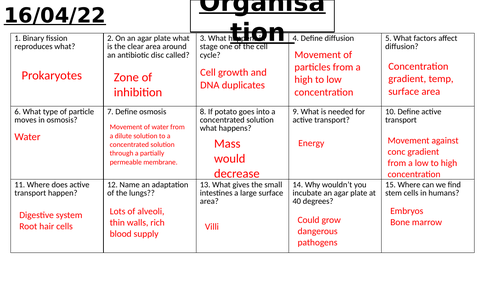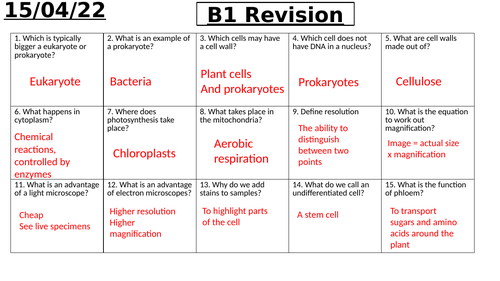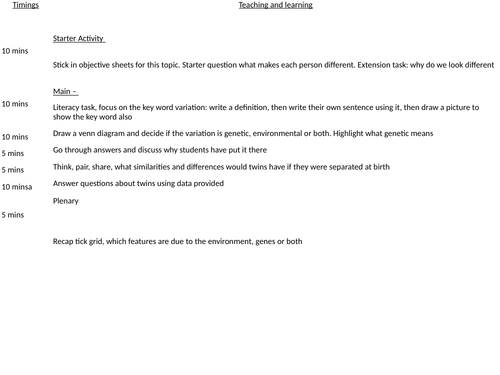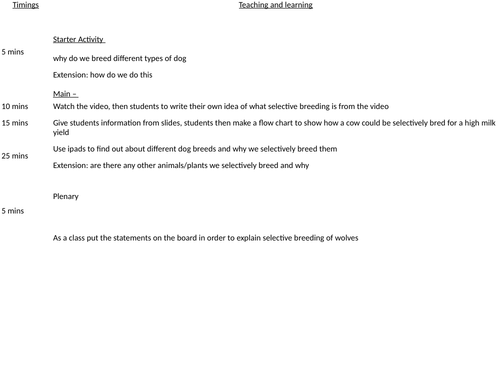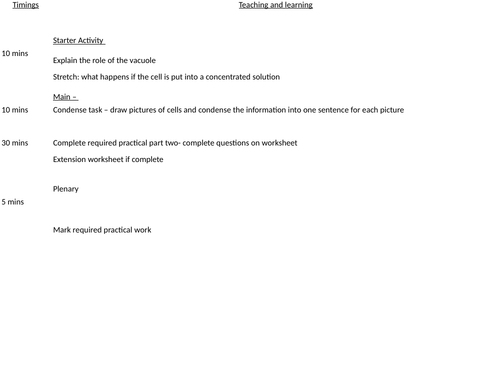
123Uploads
29k+Views
8k+Downloads
Biology

B13.1 variation and evolution
Aimed at a low ability class.
Starter Activity
Stick in objective sheets for this topic. Starter question what makes each person different. Extension task: why do we look different
Main –
Literacy task, focus on the key word variation: write a definition, then write their own sentence using it, then draw a picture to show the key word also
Draw a venn diagram and decide if the variation is genetic, environmental or both. Highlight what genetic means
Go through answers and discuss why students have put it there
Think, pair, share, what similarities and differences would twins have if they were separated at birth
Answer questions about twins using data provided
Plenary
Recap tick grid, which features are due to the environment, genes or both

B13.3 selective breeding
Aimed at a low ability class
Starter Activity
why do we breed different types of dog
Extension: how do we do this
Main –
Watch the video, then students to write their own idea of what selective breeding is from the video
Give students information from slides, students then make a flow chart to show how a cow could be selectively bred for a high milk yield
Use ipads to find out about different dog breeds and why we selectively breed them
Extension: are there any other animals/plants we selectively breed and why
Plenary
As a class put the statements on the board in order to explain selective breeding of wolves

B13.2 Evolution by natural selection
Aimed at a low ability class
Starter Activity
Pictures of animals with the albinism mutation, students decide if they think this is beneficial or not and explain their answer
Main –
Think pair share for one minute to discuss the word mutation. Then do a vocab lab for the definition
Fill in the blanks about mutations, print for LA students
Watch video about Charles darwins natural selection. Then cut and stick the statements into order to describe natural selection. Green pen mark
Explain how the lion is adapted and how these adaptations are beneficial.
Complete exam questions. Extension question available on powerpoint.
Plenary
Mark exam question

B1.1 The world of the microscope
Starter Activity
Starter questions about the microscope
Main –
Students stick microscopes in the middle of their page. Use the information on the slide to label the parts of the microscope. Extension: to explain how to use a microscope
Check answers – answers on the PowerPoint. Students check answers, ensure students know the function of each part of the microscope.
Explain magnification and resolution, get students to write the definitions.
Think pair share, pictures of light and electron microscopes, see what students can summarise as differences
Students to make a grid in their books light vs electron microscopes, make notes on any differences from the video
Sort the statements and go through answers
Explain how to work out total magnification and then practice.
Explain the magnification equation and then practice using it
Plenary
Fill in the gaps in the sentences

Osmosis required practical
Two lessons split for the required practical, differentiated sheets available and practical worksheet

Biology paper 1 revision
complete paper one revision.
Aimed at low ability foundation students.
Inspired by Dr Edmunds
Booklets include fact sheets for each topic, each fact sheet has page numbers from the CGP foundation revision guide for support.
There are answers for these fact sheets for students to check their answers.
Each topic also has a page of exam questions for students to practice their knowledge. answers for these are in the back of the booklets
Hopefully will be of help.
Any feedback welcome :)
Bundle

B1 - cell structure and transport
complete lessons covering kerboodle B1.
the world of the microscope
animal and plant cells
eukaryotic and prokaryotic cells
specialised animal cells
specialised plant cells
diffusion
osmosis
osmosis in plants
active transport
specialised exchange surfaces
Including required practicals
Lots of differentiation in lessons

